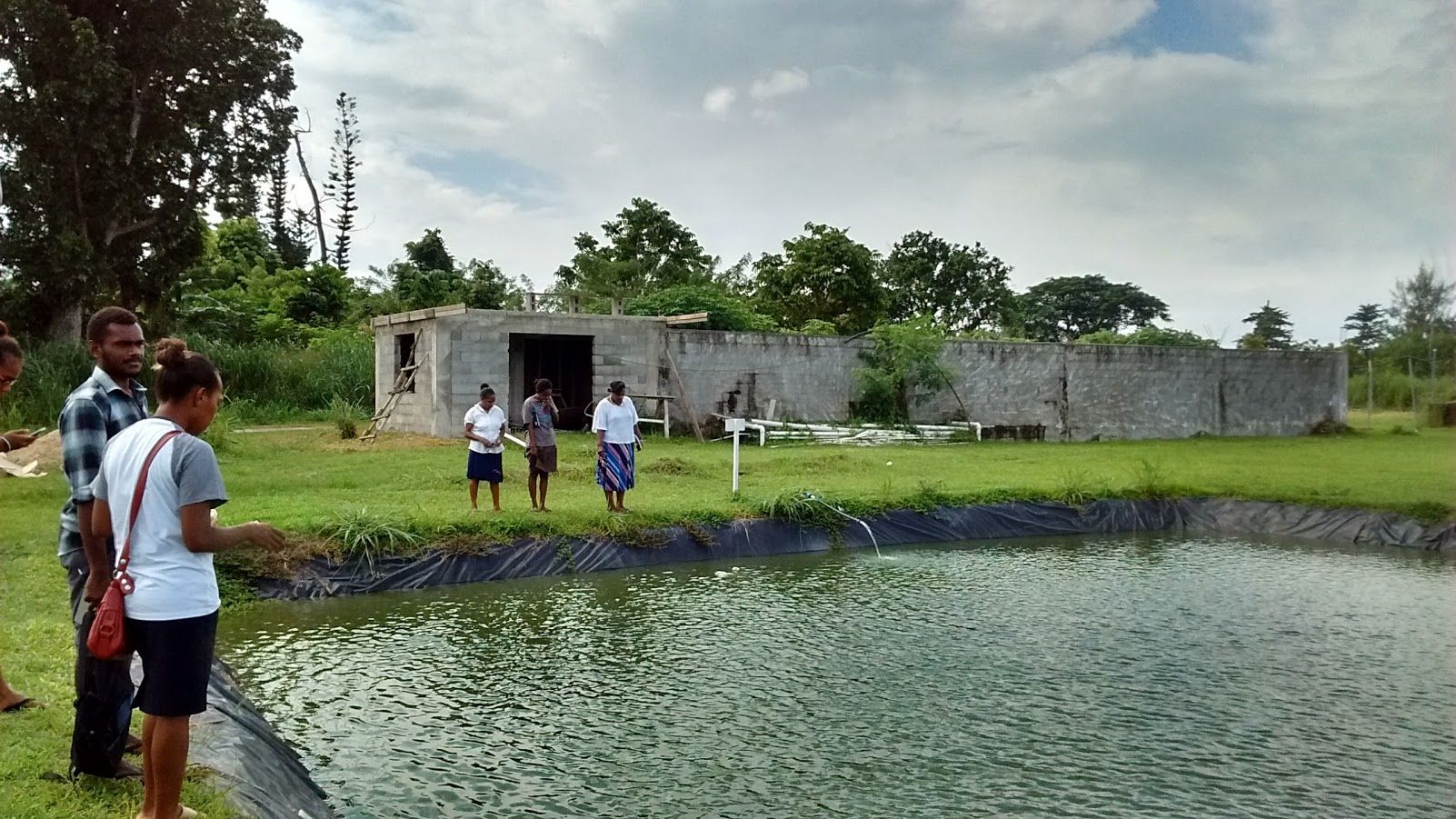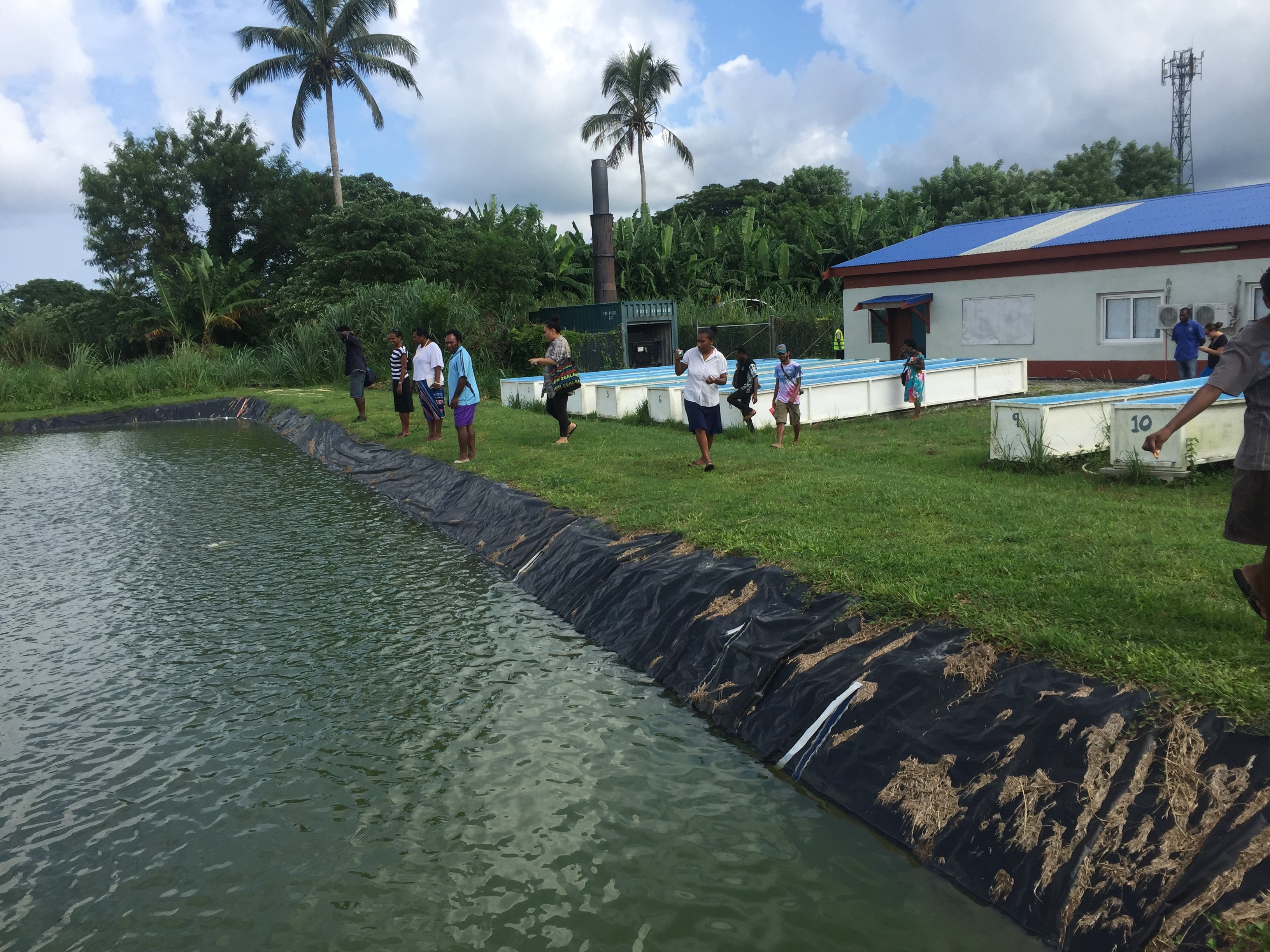By: EVELYNE TOA/Vanuatu Independent
The depletion of some major fish stocks is becoming a major source of concern not only for the Pacific region but also throughout the world due to overfishing and climate change. In Vanuatu, the number of well-managed fish and prawns ponds is currently still small in scale, but could become an important source of income in the future.
Eighteen of the twenty participants for the first ever climate training workshop for professional journalists in Vanuatu had the opportunity to visit the country’s agriculture and forestry extension unit yesterday, getting a first-hand look at aquaculture operations, a nursery for citrus plants, and how other plants are being grown for use to help Vanuatu build its resilience to climate change. For most of the participants, it is the first time they ever visited the area, although it is situated a 30 minutes drive from Port Vila city.
At the aquaculture area, Mr Andrew William, the dynamic Aquaculture Officer under the Fisheries Department, spoke from his heart to explain to journalists about the establishment of the fish and prawns ponds, the main species provided by the Vanuatu government to supply to farms in the outer islands, particularly in Santo, SANMA Province, and Maewo in PENAMA Province recently.
Efate, the central part of Vanuatu, also has some fish ponds, but on a smaller scale, like the ones owned by the Vanuatu Christian Council (VCC) in Port Vila, and one in Teouma, a few kilometres from the city.
The VCC operates four tilapia ponds that have been harvested in late 2015, few months after the destruction of category 5 tropical Cyclone Pamthat struck the country on 13th March, 2015. The harvest were donated to Vila Central Hospital (VCH) and to the Correctional Centre in Vila.
The Government funded aquaculture project was initially established in 2004, and the first import of tilapia and prawns from Fiji begun in 2009 and wwere first kept by the department of fisheries.
“This business is slowly taking shape, and growing in number in the past seven years, from 2009 to 2016. The best year of harvest was last year in 2016, a year after the destruction of cyclone Pam, where 120 kg of prawns were harvested from the two ponds they have, and were sold for VT1,500 per kg,” William said proudly. “Those were sold ‘just like magic’ and were purchased only by local ni Vanuatu. “Although we have received demands from other nationals, specially Asians from Port Vila. We explain to them due to limited stock, we have, this is only for in Vanuatu. Otherwise, no local would benefit from this.”
He took the opportunity to mention the new prawns project in Maewo, PENAMA Province. “At Talise village, with now 3000 prawns, they are expecting to harvest 7000 next month (April).”
The good news, he said, is the new Integrated Farming System, a jointly funded project by the Vanuatu Government, Japan and South Pacific Community (SPC), initially installed in Saratama, Ambae, in PENAMA Province, that is now developing.
It will be a role model project to be adopted for the whole Pacific region in the coming near future, Having ‘all in one’ breeding chickens, and plants besides the fish ponds. Currently in Ambae it has 500 prawns.
The Vanuatu government through its arms, like the Fisheries Department, is recommending the fish and prawns farms, as ‘beneficial’ for local people in Vanuatu. “It is cheap to develop, as long as people have access to a fresh water source. We can assist them to provide fish and prawns, teach them how to manage it. It is a good business, also in terms of food security, now that is entering the commercial stage of it, and can resist and still sustain even during a cyclone. We have proven it, with the severe cyclone PAM in 2015,” William said. During that period, a few months after PAM, some parts of Efate had experienced situation with dying fish from sea. Warnings were issued by relevant authorities to stop consuming fish from the sea.
There are now significant demands from local people to assist them in building ponds, now that they have come to realize the beneficial part of it. However, Williams said that due to financial constraints, “we encourage them to build and start it, we can come only to provide advice and supply of fish and prawns”.
Participants also heard that ineffectual coastal fisheries management is a real threat to the sustainability of local fisheries, and it is these fisheries that serve as the main source of nutrition and employment for our people.
Governments need to establish policies and legislation that protect fisheries resources and facilitate the ongoing supply of marine foods to coastal communities.
As Moses Amos, a ni-Vanuatu, Director of the Division of Fisheries, Aquaculture and Marine Ecosystems at SPC in Noumea, said in a recent statement issued, healthy marine and coastal environments are fundamental to the long-term sustainability of island societies, including Vanuatu, and provide the basis for both their livelihoods and economic development. Small pockets of effective coastal fisheries management cannot address the deficit of well-managed fisheries in the region.
To end the programme of the day, the field trip took participants to also visit a plot of vetiver grass, used as one of multiples ways of preventing erosion in Vanuatu, sometimes caused by sea level rise, especially in small islands, like Pele in North Efate, and Erromango in the southern part of Vanuatu.
The three-day training workshop was opened on Tuesday 28 March, by the Director of Climate Change Department, David Gibson, and was jointly run and organized by Internews’ Earth Journalism Network (EJN) and the Media Asosiesen blong Vanuatu (MAV) in partnership with the Vanuatu Government through the Vanuatu Meteorology and Geo-Hazard Department (VMGD).




